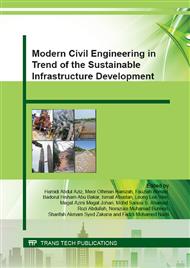[1]
M. Inel, H.B. Ozmen and H. Bilgin, Re-evaluation of building damage during recent earthquakes in Turkey, Engineering Structures, 30/2 (2007) 412-427.
DOI: 10.1016/j.engstruct.2007.04.012
Google Scholar
[2]
H. Kaplan, S. Yilmaz, Y.S. Tama, E. Akyol, and H.B. Ozmen, Seismic strengthening of state buildings: government office of Datca, Turkey, First European Conference on Earthquake Engineering and Seismology, (a joint event of the 13th ECEE and 30th General Assembly of the ESC), 3-8 September (2006).
Google Scholar
[3]
H. Kaplan, S. Yilmaz, E. Akyol and G. Sen, A new rapid seismic vulnerability assessment method for Turkey, 14th World Conference on Earthquake Engineering, Beijing, China, 12-17 October (2008).
Google Scholar
[4]
A. Ilki, F. Karadogan, S. Pala and E. Yuksel, E, (Ed. ) Seismic Risk Assessment and Retrofitting, Springer, London, (2009).
Google Scholar
[5]
CEN, Eurocode 8: Design of structures for earthquake resistance, Ref. No. prEN 1998-1: 2003 E, Brussels, (2003).
Google Scholar
[6]
UNDP/UNIDO, Post-Earthquake Damage Evaluation and Strength Assessment of Buildings under Seismic Conditions, 4, Vienna, (1985).
Google Scholar
[7]
FEMA, NEHRP Guidelines for the Seismic Rehabilitation of Buildings, Pub. No: 273, Washington D.C., (1997).
Google Scholar
[8]
D.C. Rai, IITK-GSDMA Guidelines on Seismic Evaluation and Strengthening of Existing Buildings: Provisions with Commentary and Explanatory Examples, IIT Kanpur and Gujarat State Disaster Mitigation Authority, Gandhinagar (2005).
Google Scholar
[9]
D. D'Ayala and A.W. Charleson, Review of seismic strengthening guidelines for R. C. buildings in developing countries, 12th European Conference on Earthquake Engineering, London, Paper Ref. 820, September (2002).
Google Scholar
[10]
S.T. Wasti and G. Ozcebe, (Ed. ) Seismic Assessment and Rehabilitation of Existing Buildings (NATO Science Series: IV: Earth and Environmental Sciences), Kluwer Academic Publishers, Dortrecht, (2003).
DOI: 10.1007/978-94-010-0021-5
Google Scholar
[11]
R. Rubright and S. Bandimere, Ground Improvement, (Ed. By M.P. Moseley and K. Kirsch), Spon Press, London, (2004).
Google Scholar
[12]
H. Sucuoglu, J. Jury, A. Ozmen, D. Hopkins, G. Ozcebe and J. Kubin, Developing retrofit solutions for the residential building stock in Istanbul, Proc. of the 8th US National Conference on Earthquake Engineering, San Francisco, California, USA, Paper No. 572, 18-22 April (2006).
Google Scholar
[13]
J. Warner, Practical Handbook of Grouting; Soil, Rock, and Structures, John Wiley and Sons, New Jersey, (2004).
Google Scholar
[14]
ASCE (Committee on Grouting of the Geotechnical Engineering Division), Preliminary Glossary of Terms Relating to Grouting, Journal of the Geotechnical Engineering Division, ASCE, 106(GT7) Proc. Paper 15581. (1980).
DOI: 10.1061/ajgeb6.0001006
Google Scholar
[15]
M.J. Byle and R.H. Borden, Verification of Geotechnical Grouting (Report), Geotechnical Special Publication, 57. (1995).
Google Scholar
[16]
F. Tuncdemir, Theoretical and Practical Aspects of Compaction Grouting, Digest, 1129-1140. (2007).
Google Scholar
[17]
E. Akyol, Strengthening foundations of seismically weak buildings on sandy soils in Denizli, Turkey, Environmental Earth Sciences, 66(5) (2012) 1415-1421.
DOI: 10.1007/s12665-011-1352-x
Google Scholar
[18]
S. Sun, Geology and coal resources between Denizli and Usak, M.T.A., Report No: 9985, Ankara, Turkey, (1990).
Google Scholar
[19]
Information on www. koeri. boun. edu. tr/sismo/Depremler/onemliler/ege. jpg. (2010).
Google Scholar
[20]
PAU/GEO, Geological, geotechnical and hydrogeological characteristics of Denizli Municipality, Report (in Turkish), (2002).
Google Scholar


